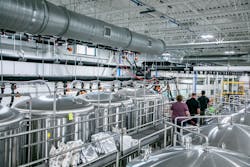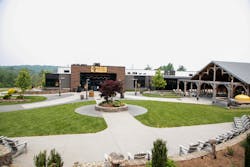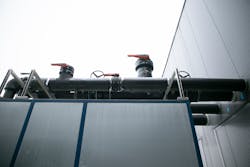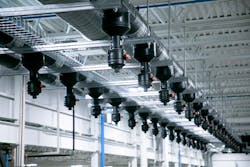Pre-Insulated Piping Aids Rise to the Top for Craft Brewer
By Katherine Bonamo
In 2011, Tree House Brewing arrived on the craft beer scene with a bang. By 2013, its now-famous “Julius” IPA had cracked Beer Advocate’s prized Top 250 List. By 2020, Tree House was the largest brewer in Massachusetts outside Boston—without traditional distribution. To this day, the only way to drink Tree House beer is to collect or consume it on site, at one of five New England locations—and beer lovers continue to line up for the privilege.
This meteoric rise may look effortless from the sidelines, but hard work and hard decisions faced the brewers at every stage. Brewing for fun in your kitchen (as co-founder Nate Lanier did first) is one thing. Brewing for the local community in your friend’s barn is another, as the Tree House team discovered when they first started selling to the public. And building your own full-scale professional brewing operation is a different level of effort entirely.
One part of the solution for Tree House was to streamline its physical expansion with COOL-FIT Pre-insulated Piping from GF Piping Systems. Lightweight plastic piping insulated at the factory meant a fast, straightforward install for the contractor. Design advice and training support from GF meant that the brewers could concentrate on what they do best—dreaming up the next Tree House cult favorite.
Building to Last
By 2016, plans were in place to build Tree House’s current headquarters, on a far larger scale in every sense. Clocking in at 55,000 square feet, the new facility in Charlton, Mass., would be more than six times the size of the old. Maximum brewing capacity would increase even more dramatically, by a factor of 18. Reflecting the economic heft of this growing concern, the $18.5M project was supported in part by a $7.7M bond from MassDevelopment.
Building again in such a short period of time—with the goal of creating a permanent base—gave Tree House the opportunity to reconsider every technical decision in its brewing operation. In this light, one important revision emerged: the choice of piping material for their cooling loop. Tree House had built its first cooling piping system from copper, traditionally regarded as a high-quality option. However, insulating the metal pipes as needed for the glycol loop at Tree House proved more troublesome than expected. Condensation would build up between the pipes and the insulation, undermining efficiency and creating unwanted dripping.
“To save the labor time in insulating, to save the money in insulating, and have a product that’s plug and play—it was huge for us,” noted Tree House co-founder Dean Rohan—a former plumber by trade. “Also: it doesn’t rot, it doesn’t rust, and it doesn’t break.”
“Not One Leak Occurred”
Eric Sweet, President of Northeast Process Systems, Inc., handled the latest piping system expansion at Charlton. Explaining that he frequently installs COOL-FIT for brewery applications, Sweet noted the appeal of its thermal performance for this industry. “Any loss of temperature from the chiller to the furthest fermenting vessel is a potential for degraded product,” he pointed out. “They couldn’t maintain the low temperature on a consistent basis with any other piping system.”
GF had consulted with Tree House on the design, layout, and size of the expansion all along the way, a partnership role that Dean Rohan appreciates. Alluding to frequent support visits from GF technical personnel, Rohan noted that COOL-FIT “doesn’t just have a pamphlet or a website that you go to. It feels like we have someone on our side all the time.” From the installation point of view, Eric Sweet valued GF’s involvement as well: “The support that we got from GF Piping Systems was spot on.”
More Than Meets the Eye
Set high on a hilltop, Tree House Charlton overlooks acres of forest in a peaceful corner of central Massachusetts. The beauty of this location clearly helps make Tree House runs a pleasure for its customers. But as with many forms of art, a solid technical foundation lies behind what meets the eye—and the palate. Creative inspiration was needed to produce Tree House’s award-winning beers—but so was engineering excellence in the brewhouse, backed by organizational commitment. If “craft” is where art and science meet, then nothing makes more sense than this craft brewer’s swift success. And for just the same reason, nothing is more likely than continued growth to come.
Katherine Bonamo writes on topics in architecture, engineering, and construction for publications throughout the United States.



